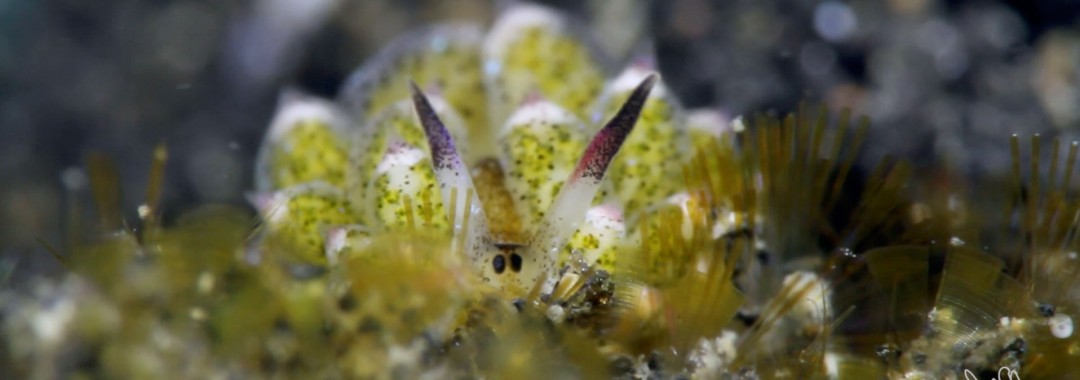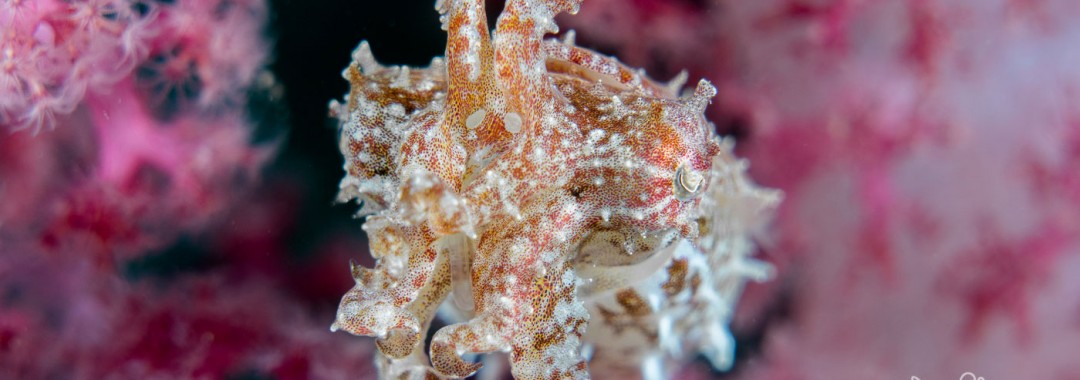Many know these adorable little sap-sucking slugs (technically not nudibranchs) as ‘Shaun the Sheep’, due to their resemblance to sheep grazing on grass. They are tiny (from just a millimeter up to about 12 millimeters maximum length) and can be found feeding on the host algae Avrainvillea spp which looks like a large, single, round green leaf which sticks up vertically out of the sand on Lembeh’s muck sites. They are members of the Sacoglossa family which is the only group of animals known to engage in kleptoplasty, a process where the sea slug stores chloroplasts from the algae it feeds on in its body and benefits from the food they produce via photosynthesis. In this detailed, close-up footage you can actually see the chloroplasts in the animals’ cerata (the pointy bits on the back), impossible to observe with the naked eye due to the creatures’ tiny size. Enjoy this detailed video showcasing a cute and also fascinating Lembeh critter and be sure to have a look to try and find some yourself next time you dive in Lembeh!
Category Archives: Underwater
Critters of the Lembeh Strait | Episode 07 | June Highlights
June was a great critter-filled month and on many days the visibility was excellent (for Lembeh ed-italia.com!) Be sure to watch for the blue-ringed octopus feasting on a crab larger than the cephalopod itself. Best watched in 4K!
Critters of the Lembeh Strait | Episode 06 – 2016 – Reef Diving in Lembeh
The Lembeh Strait is famous for all the weird critters, but there are as well colourful, thriving corals at many of the dive sites. This video shows the fantastically diverse coral at our nearby dive sites, where you can ‘have it all’ and see not only famous critters but also beautiful reefs. I couldn’t resist and had to include a few scenes of critters, shot with a fish-eye though :-). Best watched in 4K!
SEA WARS – The Skeleton Shrimp Strikes Back
Make sure your sound is turned up for this epic underwater battle between the tiny skeleton shrimps and the ‘massive’ sea hare. Will Luke Skeleton Shrimp save his young from the sudden attack? Watch ‘The Skeleton Shrimp Strikes Back’ to find out!
Critters of the Lembeh Strait | Episode 05 – 2016 | March Highlights
March was another wildly critter-filled month here in Lembeh! Among many other things we saw a seahorse wearing a funny hat, an one-eyed shrimp, a reef octopus getting his eyes cleaned and a ghost-pipefish photobombing a coconut octopus. Enjoy!
Critters of the Lembeh Strait | Episode 04 – 2016 | February Highlights
Here are some highlights from February…check out the cardinal fish – I don’t know how he manages all these eggs…crazy!
Critters of the Lembeh Strait – Episode 03 – 2016 | Frogfishes
This February is all about frogfishes…here’s a short video of some of the common species we usually see while diving the Lembeh Strait – Enjoy!
Critters of the Lembeh Strait | Episode 02 – 2016 | January Highlights
The year startet very good in Lembeh. With lots of frogfish (especially hairy ones), cephalopods (even flamboyant cuttlefish hatching) and many pretty nudibranchs, January was very productive, Here are a few highlights – enjoy!












